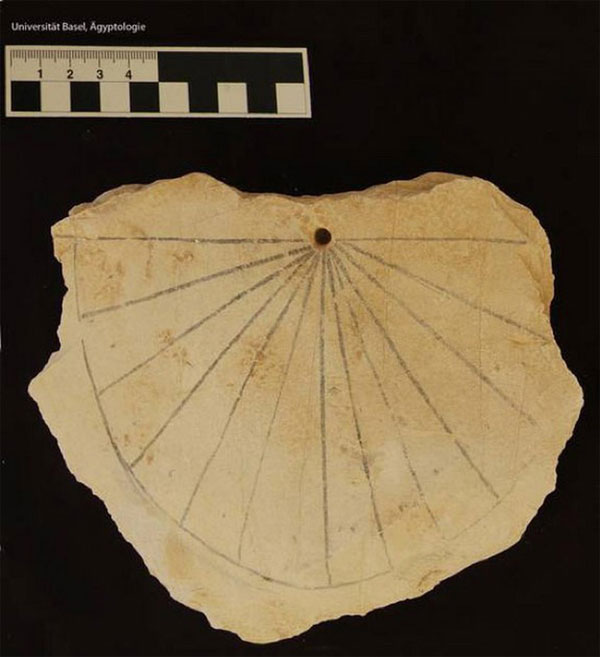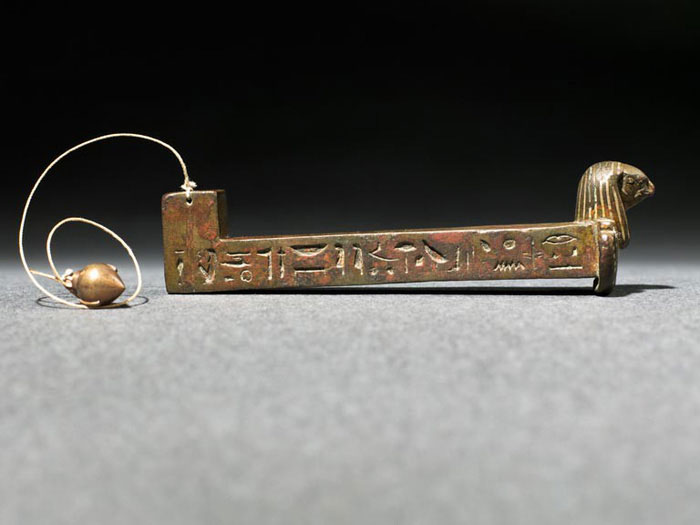The inventions help see the time before the clock
Clock is an indispensable item in daily life. But do you know how the clock is viewed before the clock is available?
Sundial

The oldest solar clock face (about 1,500 BC) of the Egyptians in the Valley of the Kings - (Documentary).
In the 3500s BC, the Egyptians began to build large columns, placed under the sunshine and watched the shadow of the column change direction and length to determine the afternoon of the afternoon.
2,000 years later, the Egyptians created a sundial with a circular disc system divided into 12 equal parts and a sun-catcher.
In the middle of the afternoon, people rotate the watch 180 degrees to indicate the afternoon time. Later developed a variety of sundial clocks with 360 degrees of rotation.
However, this type of watch is quite limited like inactive at night or days without sun. The clock is also inaccurate when different sun reflections give different reflections.
Star clock

Merkhet of ancient Egypt - (Photo: Alamy)
It was the Egyptians who invented the night time cultivation method using the merkhet astronomical device around 600 BC. This instrument is also known as folk watch.
The device consists of a straight bar attached to a plumb line (the wire has a heavy object attached to the lower end, used to determine the vertical). Astronomers place wires vertically and in the direction towards the North Star, forming a North-South line.
People count time by watching certain stars move back and forth on this boundary line.
Water clock

A ceramic water meter around the end of the 5th century BC displayed in Athens - (Photo: Marsyas).
The water meter measures the flow time of a certain amount of liquid, usually water.
The most basic water meter usually consists of a water reservoir and a catcher.
The Egyptians created the first water meter to overcome the limitations of the sundial. From Egypt, city water clocks turn to Greece and Arab countries.
Over time, people build a more complex water tank system that uses a connected tank system to indicate hours.
Candle clock

A sample of German candle clocks - (Photo: Wikipedia Commons).
The simple candle clock uses a burning candle and a continuously marked dashboard. How much the candle burns corresponds to the time lapse.
It is not known when and where exactly the candle clock was born, but scientists think this watch is popular in Asian countries like China and Japan from the 6th to 11th century.
In the 14th century, the Arab king Al-Jazari (1136-1206) invented a state-of-the-art candlestick when designing an accurate watch face with a screw joint to keep the candle tighter.
Sand watch

The iconic image of the effective government of Ambrogio Lorenzetti in 1338 features an hourglass image - (Documentary photo).
According to many documents left, the hourglass was first widely known by the French monk Luitprand in the Chartres cathedral created in the 8th century. At that time, only rich people bought hourglass, medium to see the time, just to decorate the family.
Until the 14th century, hourglass appeared popular and used by sailors to watch the time when going to sea.
The hourglass is mainly designed to measure different short periods of time: 1 hour, 30 minutes or even minutes. So the hourglass is a symbol of fast-moving time, often appearing in the art fields.
Oil lamp clock

A kind of oil lamp watch - (Photo: Wikimedia).
Oil lamp watches are similar to candle clocks. The watch is designed with an oil frame, usually whale oil used to burn lights. On the oil container, write the numbers indicating the passing time.
Scientists do not know exactly when and where this oil lamp was born, but they were used in the 18th century in the world.
Elephant clock

Drawing simulation of elephant clock system during King Al-Jazari - (Documentary photo).
The pinnacle of the main water meter system is the invention of the elephant clock of Al-Jarazri (1136-1206) the famous Arab king.
This is a complex operating system. Inside the empty elephant is a water tank and a tank of water carved into the bottom. The time for the tank to sink in the tank is 1 hour 30 minutes.
When sinking, the recoil barrel pulls the bird at the top of the tower and reports and drops 1 ball into the dragon's mouth.
The dragon with the axis of rotation continues to bring the ball into the point where it activates the robot to sit in front of the elephant and pull the drawstring barrel back into the water surface again.
So on. 1 hour and 30 minutes, people will be informed of the time.
Incense clock

Incense clock - (Photos: Pinterest).
The Chinese invented a way of measuring incense time in the Song Dynasty (960-1279) and then disseminated to neighboring countries such as Japan and Cao Ly.
The common structure of this type of watch is metal spheres that are tied along the joss stick at regular intervals by wires. When burning a piece of incense, the rope slipped off and dropped the spheres creating an alarm.
Another type of incense clock uses different incense sticks with different colors or scents to mark different time periods.
- Alarm clock history
- Human time countdown clock
- Can measure time without clock
- Will the clock be only one 120 seconds wrong for 14 billion years?
- Intelligent alarm clock
- The new clock corrects the timing
- Multilingual Speaking Clock: Voice notification time
- Tomorrow time is pulled back by a second
- What is the accuracy of the clock, and is anyone really interested in it?
- The eternal clock for 'doomsday'
- Detecting the biological clock 'adjustment button' of the human body
- Find a way to decode the biological clock
 Daily use inventions come from universities
Daily use inventions come from universities Special weight loss device helps prevent appetite
Special weight loss device helps prevent appetite 8 inventors were killed by their own inventions
8 inventors were killed by their own inventions Iran invented a motor car powered by water
Iran invented a motor car powered by water